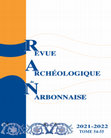Papers by Frédéric Rivière

La ville de Cahors-Divona possède un système d’évacuation des eaux usées évolué. Le topographie d... more La ville de Cahors-Divona possède un système d’évacuation des eaux usées évolué. Le topographie du terrain a nécessité une adaptation mais l’ensemble des découvertes réalisées jusqu’à aujourd’hui permettent quelques réflexions d’ensemble sur l’organisation de ce système, tant sur sa forme que sur sa mise en place. Dans le cadre de cet article, nous souhaitons aborder leur étude par l’analyse des liants architecturaux, c’est-à-dire des mortiers constitués d’un mélange de chaux et de sable, parfois de TCA. Nous verrons que ces mortiers fossilisent nombre d’informations permettant de restituer les gestes et les choix techniques effectués lors des chantiers de construction.
The city of Cahors-Divona has an evolved sewage system. The topography of the land required an adaptation but all the discoveries made until today allow some reflections on the organization of this system, both on its form and its implementation. In this article, we wish to approach their study through the study of architectural binders, i.e. mortars made of a mixture of lime and sand, sometimes TCA. We will see that these mortars fossilize a lot of information allowing to restore the gestures and the technical choices made during the construction sites.
L'étude des mortiers et des bétons s'est largement développée ces dernières années et permet de c... more L'étude des mortiers et des bétons s'est largement développée ces dernières années et permet de comprendre à la fois les techniques de construction, leur mise en oeuvre, mais aussi, plus largement, de proposer une approche socio-économique du chantier de construction. Ils sont utilisés dans différents contextes (habitat, tombeaux, édifices publics ou cultuels…). Ils assurent plusieurs fonctions, soit comme liants architecturaux garantissant la bonne cohésion des structures maçonnées ; soit comme revêtement pour recouvrir certains espaces ou parties de structures (sols, murs, canaux) ; soit comme éléments constitutifs uniques lorsqu'ils sont coffrés. Certains mortiers/bétons jouent un rôle essentiel dans la construction et l'utilisation à long terme des structures hydrauliques, en particulier dans les aqueducs. C'est précisément ce cas de figure qui retiendra notre attention.
Désolé pour la qualité du scan...
Co-auteurs : Pierre MARTY et Jean-Louis TILHARD
Teaching Documents by Frédéric Rivière
by gabriel rocque, Aurélie Ducreux, Magali Garcia, Laetitia Huguet, Gwenaelle Jaouen, Antoine Louis, Dorian Pasquier, Perrine Picq, Frédéric Rivière, Caroline Schaal, and Sabrina Save
Études et Rapports by Frédéric Rivière











Uploads
Papers by Frédéric Rivière
The city of Cahors-Divona has an evolved sewage system. The topography of the land required an adaptation but all the discoveries made until today allow some reflections on the organization of this system, both on its form and its implementation. In this article, we wish to approach their study through the study of architectural binders, i.e. mortars made of a mixture of lime and sand, sometimes TCA. We will see that these mortars fossilize a lot of information allowing to restore the gestures and the technical choices made during the construction sites.
Teaching Documents by Frédéric Rivière
Études et Rapports by Frédéric Rivière
The city of Cahors-Divona has an evolved sewage system. The topography of the land required an adaptation but all the discoveries made until today allow some reflections on the organization of this system, both on its form and its implementation. In this article, we wish to approach their study through the study of architectural binders, i.e. mortars made of a mixture of lime and sand, sometimes TCA. We will see that these mortars fossilize a lot of information allowing to restore the gestures and the technical choices made during the construction sites.